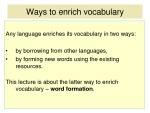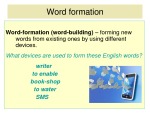Word Formation



Word Formation.
A formation is formed on the basis of another word which is called a base. A base may be composed of a root heart heart-y a root + affix hearty heart-i-ly a root + a root heartbreak heart-break-er.
The following types of word formation are used in English: derivation compounding conversion shortening (clipping, blending, alphabetisms, acronyms, etc.).
Derivational affixes should not be confused with inflectional affixes. Which of the following affixes are derivational and which are inflectional? fright-en-ed active-ate-ing pay-ment-s (Derivational affixes are inner, closer to the root, and inflectional affixes are outer, furthest from the root).
Some affixes may be both inflectional and derivational. In which sentence is the affix inflectional and in which sentence is it derivational? The boy is jogging. Jogging is healthy. He printed the letter. He saw a red-haired girl.
Derivational affixes are also classified into: class maintaining affixes to agree – to disagree to read – to reread class changing affixes to develop – development to employ – employee Some affixes can be both class changing and class maintaining: to write – writer; New York – New Yorker.
- Languages Presentations
- MS PowerPoint 5658 KB
- 2016 m.
- English
- 48 pages (1660 words)
- Kenza

















